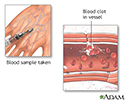Congenital protein C or S deficiency
Protein S deficiency; Protein C deficiency
Congenital protein C or S deficiency is a lack of proteins C or S in the fluid part of the blood. The proteins are natural substances that help prevent blood clots.
Causes
Congenital protein C or S deficiency is an inherited disorder. This means it is passed down through families. Congenital means it is present at birth.
The disorder causes abnormal blood clotting.
One in 300 people has one normal gene and one faulty gene for protein C deficiency.
Protein S deficiency is much less common and occurs in about 1 in 20,000 people.
Symptoms
If you have this condition, you are more likely to develop blood clots, especially at a younger age. The symptoms are the same as for deep vein thrombosis, and include:
- Pain or tenderness in the affected area
- Redness or swelling in the affected area
Exams and Tests
The health care provider will perform a physical exam and ask about your medical history and symptoms.
Laboratory tests will be done to check for proteins C and S.
Treatment
Blood-thinning drugs are used to treat and prevent blood clots.
Outlook (Prognosis)
The outcome is usually good with treatment, but symptoms may return, especially if blood-thinning agents are stopped.
Possible Complications
Complications may include:
- Childhood stroke
- More than one pregnancy loss (recurrent miscarriage)
- Recurrent clots in the veins
- Pulmonary embolism (blood clot in a lung artery)
In rare cases, using warfarin to thin the blood and prevent clots can cause brief increased clotting and severe skin wounds. People with these conditions are at risk if they are not treated with the blood-thinning drug heparin before taking warfarin.
When to Contact a Medical Professional
Contact your provider if you have symptoms of clotting in a vein (swelling and redness of the leg).
Prevention
If your provider diagnoses you with this disorder, you should be careful to prevent clots from forming. This can occur when the blood moves slowly in the veins, such as from prolonged bed rest during an illness, surgery, pregnancy or hospital stay. It may also occur after long airplane or car trips.
References
Anderson JA, Hogg KE, Weitz JI. Hypercoagulable states. In: Hoffman R, Benz EJ, Silberstein LE, et al, eds. Hematology: Basic Principles and Practice. 7th ed. Philadelphia, PA: Elsevier; 2018:chap 140.
Patterson JW. The vasculopathic reaction pattern. In: Patterson JW, ed. Weedon's Skin Pathology. 5th ed. Philadelphia, PA: Elsevier; 2021:chap 9.
Review Date: 10/16/2022
Reviewed By: Mark Levin, MD, Hematologist and Oncologist, Monsey, NY. Review provided by VeriMed Healthcare Network. Also reviewed by David C. Dugdale, MD, Medical Director, Brenda Conaway, Editorial Director, and the A.D.A.M. Editorial team.







